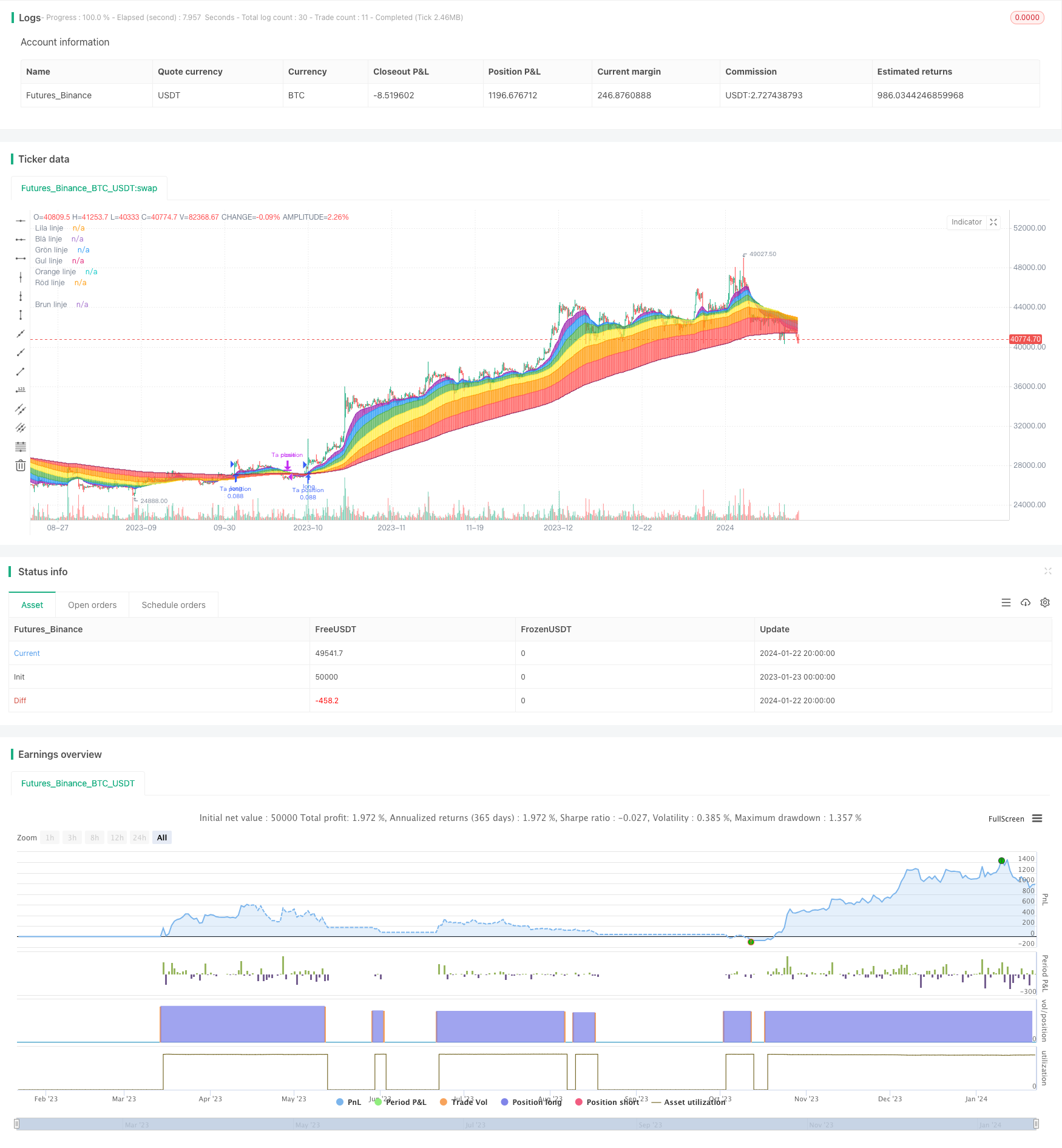
概述
本策略运用双向EMA指标判断市场主要趋势方向,并结合RSI指标作为入场时机选择,属于趋势跟随类型算法交易策略。
策略原理
- 计算多组不同周期的EMA均线,识别短期、中期和长期三个维度的市场主要趋势方向
- 当短期EMA上穿中长期EMA时,判定为看涨趋势形成
- 当短期EMA下穿中长期EMA时,判定为看跌趋势形成
- 结合RSI指标寻找合适的入场时机,RSI指标可用来判断超买超卖区域
- 在看涨趋势下,RSI指标低位时长仓做多;在看跌趋势下,RSI指标高位时介入做空
以上策略主要应用双EMA指标判断主趋势方向,并用RSI指标作为入场信号的选择,属典型的趋势跟随型算法交易策略。
策略优势分析
本策略最大的优势在于可清晰判断市场主要趋势方向,并可根据RSI指标选择较好的入场时机。具体优势如下:
- 使用多组EMA均线套,识别多时间维度下的市场主要趋势方向
- EMA指标计算简单,则噪音较小,判断市场主要趋势准确可靠
- RSI指标可有效确定入场和止损点,可大幅优化策略收益回撤比
- 算法结构清晰,容易理解修改,属于典型的趋势跟随策略
- 可灵活组合其他技术指标,进一步提高策略效果
策略风险分析
本策略也存在一定的风险,主要体现在以下几个方面:
- 趋势反转时,止损点可能过于理想化从而增加亏损
- 无法有效判断趋势反转点,可能错过及时止损退出机会
- EMA参数和RSI参数需要反复测试优化,否则可能导致不稳定
- 不能保证每次入场都是完美时机,可能出现不必要的多次反复操作
- 突发事件影响下的大幅跳空难以有效回避
针对上述风险,可从以下几个角度进行优化:
1. 合理设置止损点,防止单次亏损过大
2. 增加其他指标判断趋势反转,确保及时止损
3. 优化参数组合,使之适合更广泛市场情况
4. 修改入场和止损逻辑,减少反复操作次数
5. 增加异常情况判断,回避市场跳空的不利影响
策略优化方向
从本策略的优势和风险 out,我们可以得到以下几个可优化的方向:
- 在现有双EMA框架上,引入MACD、BOLL等其他指标,可用于判断趋势反转点,从而优化止盈止损策略
- 引入机器学习模型预测趋势反转概率,进一步提升策略效果
- 应用高级过滤器,自动识别异常行情情况,可有效防范损失
- 利用遗传算法、深度强化学习等方法自动优化参数,使策略适应更多市场类型
- 增加自动止损模块,可根据实际情况动态调整止损点
通过引入更多指标、预测模型、参数优化、风险控制模块等手段,本策略可以得到进一步提升,使得可适应更加复杂多变的市场情况。
总结
本文详细介绍了双向EMA交叉量化交易策略的主要内容。首先,概述了策略的主要思路和运作原理。然后,对策略的优势进行了全面剖析。同时,也分析了策略中可能存在的主要风险点。在此基础上,给出了几个关键的可优化方向。总的来说,本策略具有判断市场主要趋势的优势,也存在一定的可以优化的空间,属于一种典型的量化交易策略。通过不断完善和优化,本策略可以成为投资者算法交易的重要选择之一。
策略源码
/*backtest
start: 2023-01-23 00:00:00
end: 2024-01-23 00:00:00
period: 4h
basePeriod: 15m
exchanges: [{"eid":"Futures_Binance","currency":"BTC_USDT"}]
*/
// This source code is subject to the terms of the Mozilla Public License 2.0 at https://mozilla.org/MPL/2.0/
// © Investoz
// Indikatorn är byggd som ett utbildningsyfte och är därför ingen rekommendation för köp/sälj av aktier. Tanken är att skapa en visuell form i en graf
// som visar om det finns någon trend såväl positiv som negativ. En dialogruta med en varning talar om vilken trend som råder. I koden finns en möjlighet
// att ta position eller gå ur position om man vill skapa en startegi kring denna trendindikator. Rekommenderar dock starkt att inte enbart förlita sig på denna
// indikator som beslut för köp/sälj då resultaten blir negativa om man köper på psoitiv trend och säljer på negativ trend. Det måste kombineras med andra idéer
// och därför fungerar denna skript mer som ett komplement till sin egen strategi.
// Det är fritt fram för vem som helst att använda sig av denna indikator.
//@version=4
//Skapar en strategiskript med 5 % av eget kapital som ett exempel. Detta går att ändra i skriptets inställningar, välj egenskaper och sedan ändra orderstorlek
//till ett annat värde av % på eget kapital.
strategy("© Investoz trendvarningar", overlay=true, default_qty_type=strategy.percent_of_equity, default_qty_value=5)
//Lägger till inmatningar till skriptindikatorn. Användaren kan se och redigera inmatningar i objektdialogen efter eget val.
ema1 = input(21, minval=1, maxval=500, title="Lila linje")
valema1=input(true, title="Visa lila linje")
ema2 = input(34, minval=1, maxval=500, title="Blå linje")
valema2=input(true, title="Visa blå linje")
ema3 = input(55, minval=1, maxval=500, title="Grön linje")
valema3=input(true, title="Visa grön linje")
ema4 = input(89, minval=1, maxval=500, title="Gul linje")
valema4=input(true, title="Visa gul linje")
ema5 = input(141, minval=1, maxval=500, title="Orange linje")
valema5=input(true, title="Visa orange linje")
ema6 = input(230, minval=1, maxval=500, title="Röd linje")
valema6=input(true, title="Visa röd linje")
ema7 = input(371, minval=1, maxval=500, title="Röd linje")
valema7=input(true, title="Visa röd linje")
//Inmatningar för antal staplar
startbar = input(1, minval=1, maxval=1, title="Första stapeln")
Endbar = bar_index
//Källa input, stängning. Användaren kan själv byta till vilken källa som önskas.
src = input(close, title="Source")
//Antal staplar sedan den längsta ema började och framåt.
tid=Endbar + startbar - 371
//EMA loop
aema1 = ema(src, ema1)
bema2 = ema(src, ema2)
cema3 = ema(src, ema3)
dema4 = ema(src, ema4)
eema5 = ema(src, ema5)
fema6 = ema(src, ema6)
gema7 = ema(src, ema7)
//Skriver ut linjer i diagrammet om förhållandet är sant, annars falskt.
h=plot(valema1 ? aema1 : na, title="Lila linje", style=plot.style_line, linewidth=1, color=color.purple)
i=plot(valema2 ? bema2 : na, title="Blå linje", style=plot.style_line, linewidth=1, color=color.blue)
j=plot(valema3 ? cema3 : na, title="Grön linje", style=plot.style_line, linewidth=1, color=color.green)
k=plot(valema4 ? dema4 : na, title="Gul linje", style=plot.style_line, linewidth=1, color=color.yellow)
l=plot(valema5 ? eema5 : na, title="Orange linje", style=plot.style_line, linewidth=1, color=color.orange)
m=plot(valema6 ? fema6 : na, title="Röd linje", style=plot.style_line, linewidth=1, color=color.red)
n=plot(valema7 ? gema7 : na, title="Brun linje", style=plot.style_line, linewidth=1, color=color.maroon)
//Fyller bakgrunden mellan två linjer med en viss färg.
fill(h, i, color = color.purple,transp=34)
fill(i, j, color = color.blue,transp=34)
fill(j, k, color = color.green,transp=34)
fill(k, l, color = color.yellow,transp=34)
fill(l, m, color = color.orange,transp=34)
fill(m, n, color = color.red,transp=34)
//Skapa en algoritm för positiv trend
PositivTrend = crossover(aema1,gema7)?1:0
TrendPositiv = ema(close,1) > aema1 and aema1 > bema2?1:0
//Skapa en algoritm för negativ trend
NegativTrend = crossunder(aema1,gema7)?1:0
TrendNegativ = ema(close,1) < aema1 and aema1 < bema2?1:0
//Skapar en textruta med varningstext för positiv trend
varningtextpositiv = "Varning för positiv trend."+"\n" + "Leta efter att ta position!"
// if PositivTrend
// varningpositiv=label.new(
// bar_index,
// low,
// xloc=xloc.bar_index,
// yloc=yloc.price,
// color=color.black,
// textcolor=color.green,
// text=varningtextpositiv,
// style=label.style_label_down,
// textalign=text.align_left)
//Skapar en textruta med varningstext för negativ trend
varningtextnegativ = "Varning för negativ trend."+"\n" + "Leta efter utgången!"
// if NegativTrend
// varningnegativ=label.new(
// bar_index,
// low,
// xloc=xloc.bar_index,
// yloc=yloc.price,
// color=color.black,
// textcolor=color.red,
// text=varningtextnegativ,
// style=label.style_label_up,
// textalign=text.align_left)
//Köp om positiv trend
if (PositivTrend)
strategy.entry("Ta position", strategy.long, when = PositivTrend)
//Sälj om negativ trend
if (NegativTrend)
strategy.close("Ta position", when = NegativTrend, comment="Gå ur position")
//Beräkning av positiv trend
vspositiv(positiv)=>valuewhen(Endbar==startbar,positiv,0)
vepositiv(positiv)=>valuewhen(Endbar==Endbar,positiv,0)
positivmean(TrendPositiv)=>
csumpositiv = cum(TrendPositiv)
//Slut//
a = vepositiv(csumpositiv)
//Start//
b = vspositiv(csumpositiv)
//Slut - Start//
(a - b)/(tid)
positivmeanpositiv = positivmean(TrendPositiv)
//Beräkning av negativ trend
vsnegativ(negativ)=>valuewhen(Endbar==startbar,negativ,0)
venegativ(negativ)=>valuewhen(Endbar==Endbar,negativ,0)
negativmean(TrendNegativ)=>
csumnegativ = cum(TrendNegativ)
//Slut//
a = venegativ(csumnegativ)
//Start//
b = vsnegativ(csumnegativ)
//Slut - Start//
(a - b)/(tid)
negativmeannegativ = negativmean(TrendNegativ)
//Inmatning av text som ska in i texruta som visar antal staplar i trend
logga = "© Investoz: Trend i tid"+ "\n"
streck = "--------------------------------------------------------"
totalastaplar = "\n" + "Dagar totalt: " + tostring(tid)+ " dagar "+"\n"+ streck + "\n"
totalpositiv = "Dagar totalt i positiv trend "+" 📈 : " +tostring(positivmeanpositiv*tid, "##.##") +" dagar " + "\n"
totalnegativ = "\n" + "Dagar totalt i negativ trend" + " 📉 : " +tostring(negativmeannegativ*tid, "##.##") +" dagar "
//Textruta för antal staplar i trend
// if barstate.ishistory
// barcountlbl=label.new(
// bar_index,
// low,
// xloc=xloc.bar_index,
// yloc=yloc.price,
// color=color.black,
// textcolor=color.yellow,
// text=logga+streck+totalastaplar+totalpositiv+streck+totalnegativ,
// style=label.style_label_lower_left,
// textalign=text.align_left)
// label.delete(barcountlbl[1])
//////////////////////////////////